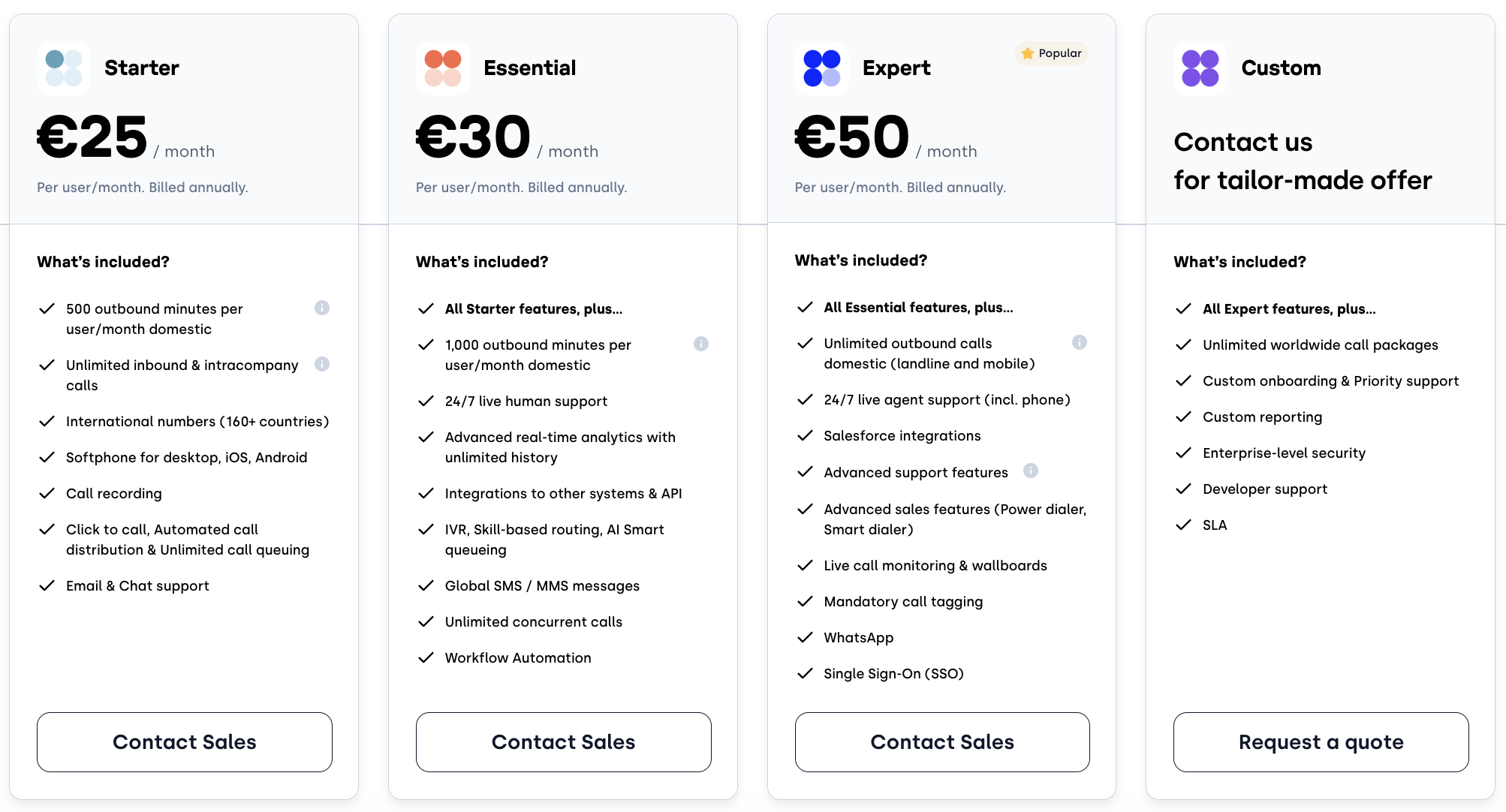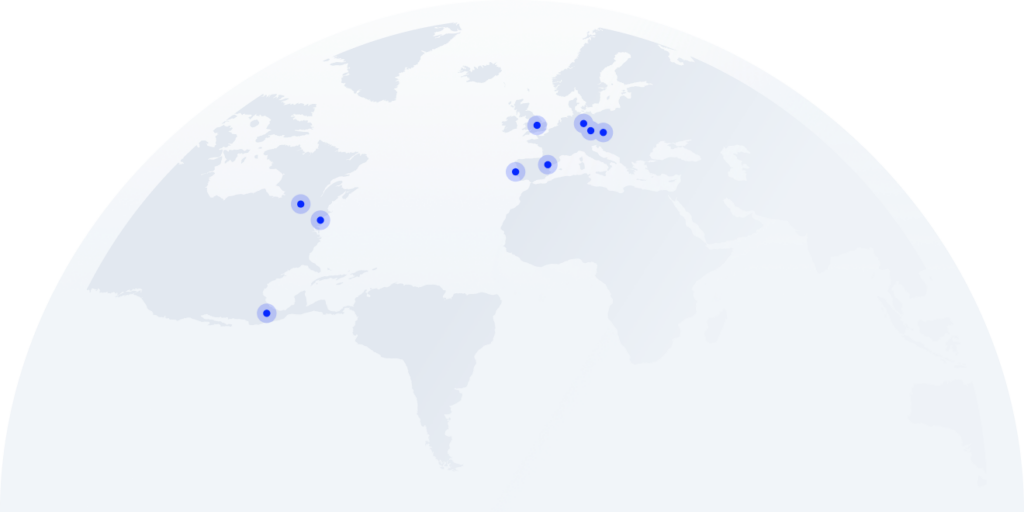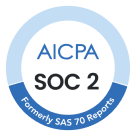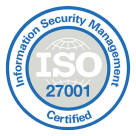
The Salesforce Lightning Dialer was rebranded to Sales Dialer in February 2024, but its features haven’t changed much. In fact, its list of 30+ limitations remains the same*.
Salesforce provides robust, comprehensive solutions for Customer Relationship Management (CRM). But does its Sales Dialer live up to the same standard?
In this detailed pricing analysis, we’ll break down Salesforce Dialer pricing, features, and costs to give business leaders a clear understanding of what to expect before making an investment. Keep reading to find out!
Key Takeaways
- Sales Dialer offers three plans–Inbound ($5 per user/month), Outbound ($25 per user/month), and Minutes ($15 for 1,000 min/org/month)–that need to be purchased together if you want to able to make and receive calls.
- Its exclusive integration within the Salesforce ecosystem, combined with a lack of advanced calling features, limits Sales Dialer to very basic functionality, often making it inconvenient and unsuitable for more dynamic business needs.
- Given its capabilities, Sales Dialer is best suited for large enterprises already leveraging Salesforce solutions and needing basic calling functions. However, for businesses seeking more advanced features, integrating with other providers becomes inevitable.
Running a small business?
Overview of Salesforce Dialer Pricing & Plans
Salesforce Sales Dialer, or Salesforce Lightning Dialer, works as an add-on feature for Salesforce CRM that provides basic telephony capabilities directly from the Salesforce platform. Through Salesforce Customization, businesses can seamlessly integrate the Dialer into their existing workflows, tailoring the experience to match unique sales processes and user needs.
Unlike most phone system providers, which divide their tiers based on the number of features available and calling capacity, Salesforce Dialer’s plans have been grouped by function: inbound and outbound calls.
Therefore, to be able to receive and make calls, you will need to buy all the plans available: Outbound, Inbound, and Minutes. Take a look at what they offer:
Feature
Inbound
Outbound
Minutes
Starting Price
$5 per user/month
$25 per user/month
$15 for 1,000 min/org/month
International Calling
Multiple Devices
Toll-free Numbers
Incoming Call Receipt
Multiple Voicemail Drop
Local Number
Native Salesforce CRM Integration
Accepting Incoming Calls
Automatically Look Up Callers’ Records
Missed Call Notifications
Incoming Call Forwarding
User-Selected Local Phone Number
Leave Prerecorded Voicemail Messages
Personal Voicemail
Intelligent Call Routing
Native Outbound Dialing
Call Monitoring
Click to Dial Functionality
Direct Dial from Native Dial Pad
Note-Taking During Calls
Automatically Log Calls to Related Records
Call History View
Call-List Creation
Shared Minutes
Get started today with 50% off your first month and say goodbye to comparing vendors.
Inbound Plan
The Inbound Plan, priced at $5 per user per month (billed annually), is specifically designed for support teams and companies that operate in a reactive mode, addressing customer demands as they arise. This plan only supports incoming calls.
Outbound Plan
The Outbound Plan is tailored for sales teams and businesses that prioritize proactive customer outreach. Its price starts at $25 per user per month (billed annually), and it allows agents to call leads, prospects, and existing customers directly from Salesforce.
Salesforce Dialer’s Related Apps and Add-Ons
Salesforce has a few extra packages to level up what Sales Dialer can do. They are designed to offer advanced call-handling features and deeper data analysis, helping teams perform at their best and make more informed decisions.
Sales Engagement
This platform is designed to enhance sales productivity by integrating engagement tools directly into Salesforce CRM. It provides sales representatives with a unified workspace with multiple channels, including email, phone, and social media. Additionally, the platform leverages AI-driven insights to help identify prospects with the highest likelihood of conversion.
Price: $50 per user/month bullied annually.
Key features: Call Queuing, Sales Candences, Lead Scoring
Einstein Conversation Insights
It is a conversation intelligence tool designed to improve individual sales conversations and enhance performance. It enables users to extract call insights, identify trends, close deals, and create more efficient sales teams.
Price: $100 per user/month bullied annually.
Key features: Video and Call Record, Transcripts, Call Insights Dashboard.
Sales Program
It offers a no-code Program Builder, allowing for rapid deployment of sales initiatives such as pipeline generation, cross-selling, and new product introductions. With features like Revenue Milestones and Enablement Analytics, sales leaders can monitor progress and gain insights to optimize programs over time.
Price: Starts at $50 per user/month bullied annually.
Key features: Analytics, Revenue Milestones, In-App Coaching.
Revenue Intelligence
This platform empowers sales teams with AI-driven analytics and actionable insights throughout the entire sales and revenue cycle. It gives a holistic view of the pipeline and enables accurate sales forecasting and performance tracking.
Price: Starts at $220 per user/month bullied annually.
Key features: Predictive Forecasting, Revenue Insights Dashboards, and Industry Dashboard Templates.
Unpacking Salesforce Dialer’s Limitations
Salesforce is well-known for its robust CRM platform and extensive suite of tools to support sales and customer engagement. However, Salesforce’s Sales Dialer phone system lacks the depth and versatility offered by dedicated telephony solutions like CloudTalk.
Even for businesses that use Salesforce as a CRM, using Sales Dialer as a telephony solution imposes critical limitations that force companies to look for third-party integrations.
Below, we explore the main areas where Sales Dialer may not meet the needs of businesses requiring a more comprehensive telephony solution.
Paying Extra to Piece It All Together
Sales Dialer divides services into three tiers: Outbound, Inbound, and Minutes. At first, this might sound like a flexible setup, but it’s not the case here.
If your business needs to make and receive calls, you’ll have to pay for all three together. This means $45 per user/month billed annually for 1,000 minutes distributed for incoming and outgoing calls.
They’ve essentially broken down a basic phone system into separate pieces, and you’re left footing the bill to put it all back together.
Staying Apart From The World
Another big downside of Sales Dialer is its limited reach. It only works for calls within the US and Canada, which is a real problem if your business has international customers or operations.
On top of that, the local number feature is restricted to US locations, so if you need numbers from other countries, you’re out of options. And forget about making international calls—Sales Dialer doesn’t support them at all. For businesses with a global focus, these limitations can be a dealbreaker.
Trapped in a Closed Ecosystem
Sales Dialer is tightly integrated into the Salesforce ecosystem, which means you’re locked into their network. If your business uses other applications in your tech stack, you won’t be able to connect your phone system to them.
Unlike more flexible solutions like CloudTalk, which integrates with multiple platforms, the Sales Dialer Salesforce closed system limits your ability to streamline workflows or share data across tools.
Tied to Desk-Bound Calling
With Sales Dialer, your team is basically stuck at their desks to make or take calls. Its features are restricted to desktop use, forcing your team to remain in front of computers.
These days, mobility isn’t just nice to have—it’s a must. Without the option to handle calls on the go, remote teams, traveling employees, or anyone working outside the office are left stuck. Important calls happen when we least expect them.
Overview of CloudTalk Pricing and Plans

Starting at $19 and reaching up to $50 per user monthly, CloudTalk’s five main plans cater to a range of needs, with an additional custom plan available for specialized requirements. Here’s a breakdown of the options:
- Lite: Design for early-stage startups focused on keeping costs low while scaling and companies transitioning from landline to VoIP solutions. For now, it is limited to the Americas (NAM + LATAM).
Key Features: SMS/MMS, Business Hours, Personalized greetings & Music.
Price: $19 per user/month - Starter: Ideal for small and micro-businesses, the Starter plan is easy to set up and provides essential features to get your call center operations up and running.
Key Features: Click-to-Call, Voicemail, Call Flow Designer (CFD), Automatic Call Distribution (ACD).
Price: $25 per user/month - Essential: This plan supports growing SMBs and MMBs by enhancing both inbound and outbound operations with advanced automation and customer experience features.
Key Features: SMS/MMS, Interactive Voice Response (IVR), Skill-Based Routing, Callback, Integrations + Open API
Price: $35 per user/month - Expert: Geared towards MMB and scaling businesses, the Expert plan equips teams with advanced tools to improve customer interactions, boost productivity, and drive operational efficiency.
Key Features: Power Dialer, Smart Dialer, VIP Queues, WhatsApp Inbound & Outbound Messages, Call Monitoring.
Price: $50 per user/month - Custom: For companies with complex, large-scale requirements, the Custom plan offers a fully tailored solution, allowing businesses to scale seamlessly and operate across diverse markets.
Key Features: Custom Onboarding, Unlimited Outbound Calls with Flat Rates, Enterprise-Level Security, and Developer Support.
Price: Based on selected features, team size, and other requirements.
CloudTalk vs. Salesforce Sales Dialer: Feature Face-Off
If you are trying to decide between ClouTalk and Salesforce Sales Dialer, say no more. Here’s a straightforward comparison of both platforms.
Feature
CloudTalk
Sales Dialer
500 / 1,000 / Unlimited
Based on plan, worldwide
Limited to US and CA, with minutes sold separately
From the Essential plan
($30 per user/month)
As an add-on, starting at $50 per user/month.
Domestic Calls
500 / 1,000 / Unlimited
Based on plan, worldwide
Unlimited within your country, the US and Canada
Available from Expert plan ($50 per user/month)
As an add-on, starting at $50 per user/month.
Not convinced about CloudTalk? Then, see for yourself.
CloudTalk Vs. Salesforce Sales Dialer: Key Takeaways
To make your decision even easier, we’ve broken down each platform’s top perks so you can see exactly what each offers and make the best choice with confidence.
- Flexibility and Integration: One of the biggest problems with Sales Dialer is that it’s stuck in the Salesforce bubble. You simply can’t connect it with other key tools like Zendesk or HubSpot. This can create inefficiencies, scattered data, and extra work for your team. CloudTalk solves this problem with its flexibility and wide range of integrations.
- Geographic Reach: CloudTalk excels in global connectivity, providing crystal-clear call quality in over 160 countries. In contrast, Sales Dialer is limited to calls within the US and Canada, with local numbers restricted to US locations, making it far less suited for businesses with international reach.
- Better-served business: Sales Dialer covers the essentials like click-to-dial, voicemail drop, and local presence dialing—great for simple call management but not much more. CloudTalk, on the other hand, goes way further with features like intelligent call routing, IVR menus, and real-time analytics. It’s the difference between just handling calls and truly optimizing how your team communicates.
Sales Dialer’s Best Features
Here’s what users appreciate most, according to Salesforce Dialer reviews:
- Click-to-Dial: Initiate calls directly from the Salesforce interface by clicking on a contact’s phone number, streamlining the calling process and reducing manual effort.
- Automatic Call Logging: Calls are automatically logged within Salesforce, ensuring accurate record-keeping and saving time on manual data entry.
- Voicemail Drop: Leave pre-recorded voicemail messages with a single click, allowing sales reps to efficiently handle calls that go to voicemail and maintain productivity.
CloudTalk: Putting You in the Cloud, Where the Sky is the Limit
The significant shortcomings of Sales Dialer are no secret. Even Salesforce highlights a long list of its limitations on its helpdesk center*, making Sales Dialer look like a wireless phone with strings attached.
Sales Dialer’s restricted geographic reach, lack of advanced features, and dependence on the Salesforce ecosystem make it a tough fit for modern businesses. Add in its tiered pricing and desktop-only setup, and it starts to feel pretty rigid and outdated—far from competitors.
In contrast, CloudTalk fills out all those gaps, giving you the flexibility of a cloud-based solution. With expansive global coverage, seamless integration with popular tools (including Salesforce), and a host of advanced features, CloudTalk delivers everything your sales and support teams need to excel.
There’s always room for one more in the clouds. Come see what CloudTalk can do.














